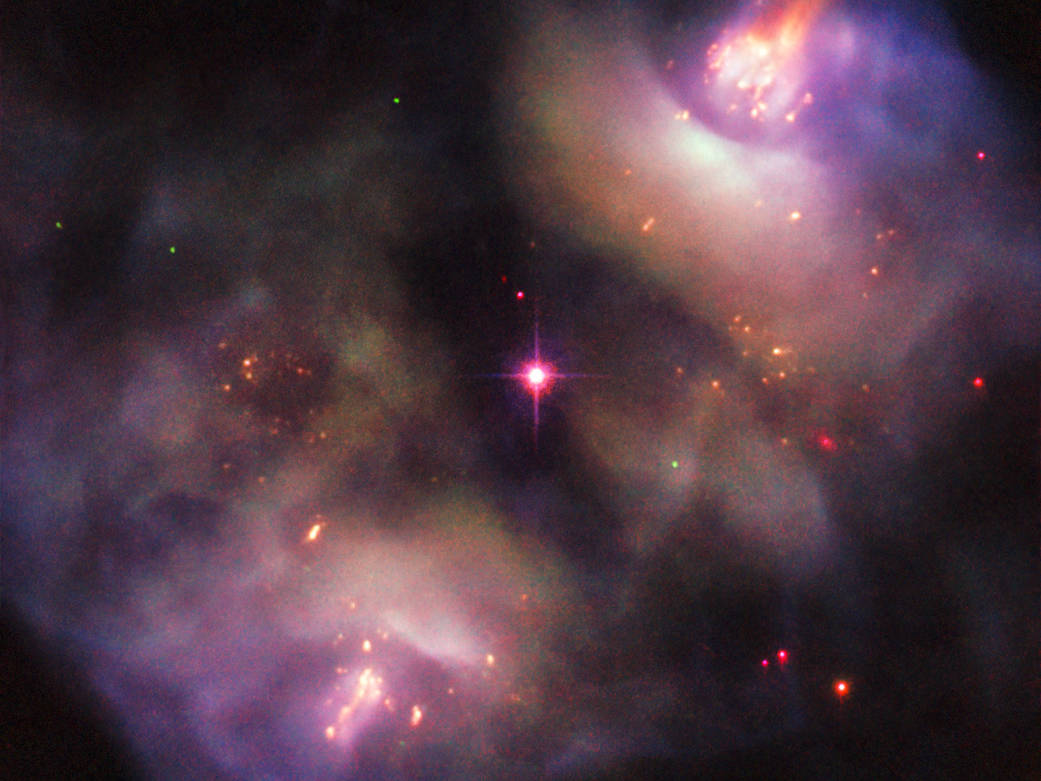This atmospheric image taken with the NASA/ESA Hubble Space Telescope shows a dark, gloomy scene in the constellation of Gemini (the Twins). The subject of this image confused astronomers when it was first studied — rather than being classified as a single object, it was instead recorded as two objects, owing to its symmetrical lobed structure (known as NGC 2371 and NGC 2372, though sometimes referred to together as NGC 2371/2).
These two lobes are visible to the lower left and upper right of the frame, and together form something known as a planetary nebula. Despite the name, such nebulas have nothing to do with planets; NGC 2371/2 formed when a Sun-like star reached the end of its life and blasted off its outer layers, shedding the constituent material and pushing it out into space to leave just a superheated stellar remnant behind. This remnant is visible as the bright star at the center of the frame, sitting neatly between the two lobes.
The structure of this region is complex. It is filled with dense knots of gas, fast-moving jets that appear to be changing direction over time, and expanding clouds of material streaming outwards on diametrically opposite sides of the remnant star. Patches of this scene glow brightly as the remnant star emits energetic radiation that excites the gas within these regions, causing it to light up. This scene will continue to change over the next few thousand years. Eventually the knotty lobes will dissipate completely, and the remnant star will cool and dim to form a white dwarf.
Text credit: ESA (European Space Agency)
Image credit: ESA/Hubble & NASA, R. Wade et al.
这张由美国宇航局/欧洲航天局哈勃太空望远镜拍摄的大气图像显示了双子座中黑暗、阴郁的景象。这幅图像的主体在最初研究时让天文学家感到困惑——由于其对称的叶状结构(被称为NGC 2371和NGC 2372,尽管有时一起被称为NGC 2371/2),它没有被归类为一个单一的天体,而是被记录为两个天体。
这两个裂片在画面的左下角和右上角都可以看到,它们共同形成了一个行星状星云。尽管如此,这些星云与行星并无关系;2371/2是由一颗类日恒星在其生命末期爆炸,脱离其外层,剥离构成物质,将其推入太空,只留下一个过热的恒星残骸而形成的。这部分残骸清晰可见,就像框架中央的一颗明亮的星星,整齐地坐落在两个叶瓣之间。
这个地区的结构很复杂。它充满了密集的气体结,快速移动的喷流似乎在随着时间的推移而改变方向,以及向外扩散的物质云,这些物质云沿着残余恒星完全相反的两侧向外流动。这一场景的部分区域会发出明亮的光,因为残留的恒星发出能量辐射,激发这些区域内的气体,使其发光。在未来的几千年里,这种情况将继续发生变化。最终,多节的裂片将完全消散,剩下的恒星将冷却并变暗,形成一颗白矮星。
资料来源:ESA (European Space Agency)
图片来源:ESA/Hubble & NASA, R. Wade et al.




cool